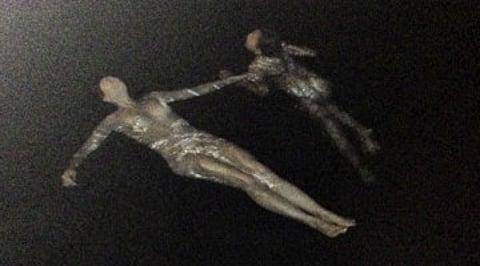Liberation as a state of mind
Steve Sabella’s images explore the connotations of occupation and the path to reclaim one’s identity

Berlin-based Palestinian artist Steve Sabella is known for his large-scale, abstract and sharp photographs. But his latest show in Dubai, “Independence”, is different. The photographs in this series are much smaller and have a diffused, dreamlike quality. They feature two anonymous figures suspended in a dark space. The figures seem peaceful yet unsettled; connected yet independent. They look almost like X-ray images, and a closer look reveals distortions and broken bones in the bodies.
The disintegrating bodies, floating in an unknown space and time, convey the anxiety of uncertainty as well as the joy of liberation. Their ambiguity evokes the dualities of Utopia versus dystopia; internal versus external; freedom versus dependence; and suspension versus catharsis.
Sabella was born in occupied Jerusalem in 1975 and has lived in the city for many years. His experience of living under occupation made him realise that Palestinians have become victims of systems and strategies designed to colonise not just their land but also their imagination; and that they must liberate their mind from occupation before they can free their land.
His earlier series, such as “Exile”, “Euphoria” and “Beyond Euphoria”, were part of a process of liberating himself from the confines of his own mental images of his identity and history. The “Independence” series takes this concept beyond the specific issue of Palestine to the general idea of liberating ourselves by constructing our own reality.
Weekend Review spoke to Sabella about his work and the philosophy behind it. Excerpts:
What technique did you use to create these images?
I usually spend a lot of time in planning my projects. But the idea for this one came to me in a flash while I was on a road trip and not carrying my camera. So I used my smartphone to take the pictures. I believe art is about image making and not about what medium is used to make the image.
Why is this body of work titled, “Independence”?
Firstly, because by using a smartphone, I freed myself from the medium in this series. Independence refers to the fact that my art and life is a process of liberating the imagination. From the 1990s, I have been exploring states of mind and the political, cultural and social colonisation of the mind. These figures could be floating in outer space or in our subconscious. They are independent of any narrative, so that viewers are free to perceive and interpret them in their own way.
What is your concept of the colonisation of the imagination and of dealing with it as an artist?
In occupied Jerusalem, I felt as though I was in exile despite living in the city of my birth. I then realised that my idea of Jerusalem was a constructed image, and that the Israelis are playing games with that image. I managed to free myself from this occupation of the mind, by a process where I transformed my state of mind and issues I had to deal with into a visual form that I could explore and decode. Each series I worked on took me deeper, helping me to unfold visual palimpsests and explore the multiple layers of my past and the influence of perception on my reality. I realised that even Palestinians living outside Palestine feel they are under occupation because they suffer from a colonisation of their mind and imagination; and that we must wake up and declare our independence, because only when we are free inside can we begin the journey to free our land. In fact, I formally declared my independence on my website during the recent conflict in Gaza to tell the world that we refuse to be enslaved any methods and systems devised to occupy our minds.
Does your Palestinian origin affect or limit the reading of this work to Palestinian history and recent events in Gaza?
It is inevitable that people will see that political connotation in my work. But I believe my work goes beyond this context and is universal and timeless. This show is the last of four exhibitions I presented this year. They include “Fragments” (in London); “Layers” (in Kuwait) and “Archaeology of the Future” (in Verona). In these interconnected shows, I have divorced my work from any narratives of space, time and history so that it can be seen from a fresh perspective.
Today, I see myself as an archaeologist, digging into visual palimpsests to uncover the hidden layers in a quest to decode the visual puzzle, which is the world we live in. I want to defy the constructed label of “Sabella - the Palestinian artist” and advocate global citizenship with no mental and physical borders. This work is about my personal journey of liberation, and the viewers are free to find their own meanings in it.
What do the broken bones and disintegrating bodies in this series signify?
Even though I grew up in occupied Jerusalem I was able to create my own freedom in my mind. But, I had to break my bones to become more malleable to change. The disintegration of these bodies reflects the process of deconstruction and reconstruction I had to go through in this process of liberation. It shows that we have the power to construct and live in a reality of our choice.
Independence will run at Meem Gallery until December 6.
Sign up for the Daily Briefing
Get the latest news and updates straight to your inbox



